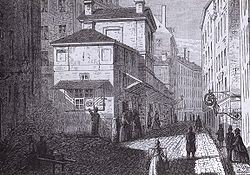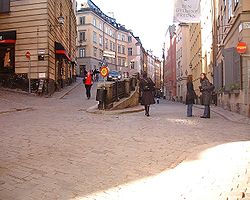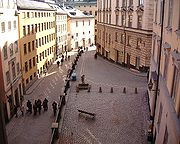
Benickebrinken
Encyclopedia

Swedish language
Swedish is a North Germanic language, spoken by approximately 10 million people, predominantly in Sweden and parts of Finland, especially along its coast and on the Åland islands. It is largely mutually intelligible with Norwegian and Danish...
: "Southern/Northern Slope of Benicke") are two sloping street
Street
A street is a paved public thoroughfare in a built environment. It is a public parcel of land adjoining buildings in an urban context, on which people may freely assemble, interact, and move about. A street can be as simple as a level patch of dirt, but is more often paved with a hard, durable...
s in Gamla stan
Gamla stan
Gamla stan , until 1980 officially Staden mellan broarna , is the old town of Stockholm, Sweden. Gamla stan consists primarily of the island Stadsholmen. The surrounding islets Riddarholmen, Helgeandsholmen, and Strömsborg are officially part of, but not colloquially included in, Gamla stan...
, the old town in central Stockholm
Stockholm
Stockholm is the capital and the largest city of Sweden and constitutes the most populated urban area in Scandinavia. Stockholm is the most populous city in Sweden, with a population of 851,155 in the municipality , 1.37 million in the urban area , and around 2.1 million in the metropolitan area...
, Sweden
Sweden
Sweden , officially the Kingdom of Sweden , is a Nordic country on the Scandinavian Peninsula in Northern Europe. Sweden borders with Norway and Finland and is connected to Denmark by a bridge-tunnel across the Öresund....
, stretching from Österlånggatan
Österlånggatan
Österlånggatan is a street in Gamla stan, the old town of Stockholm, Sweden. Stretching southward from Slottsbacken to Järntorget, it forms a parallel street to Baggensgatan and Skeppsbron...
up to Svartmangatan.
The Salvation Army
Salvation Army
The Salvation Army is a Protestant Christian church known for its thrift stores and charity work. It is an international movement that currently works in over a hundred countries....
opened a pantry on Number 2 in 1891 and a night refuge for homeless men the following year, both institutions remained in operation until the 1970s. Today the building is used as a board-and-lodging accommodation for alcoholics.
Public toilets were installed under the slope in 2005-2006.
Etymology

The slopes were originally named Svartbrödrabrinken and Svartmunkabrinken ("Black Brother's/Monk's Slope") after the Black Friars' Monastery located on the western side of the southern slope until the Reformation
Protestant Reformation
The Protestant Reformation was a 16th-century split within Western Christianity initiated by Martin Luther, John Calvin and other early Protestants. The efforts of the self-described "reformers", who objected to the doctrines, rituals and ecclesiastical structure of the Roman Catholic Church, led...
(1520-1530). The monastery was built on land given to the Dominicans
Dominican Order
The Order of Preachers , after the 15th century more commonly known as the Dominican Order or Dominicans, is a Catholic religious order founded by Saint Dominic and approved by Pope Honorius III on 22 December 1216 in France...
following the coronation of King Magnus Eriksson
Magnus IV of Sweden
Magnus Eriksson as Magnus IV was king of Sweden , including Finland, as Magnus VII King of Norway , including Iceland and Greenland, and also ruled Scania . He has also vindictively been called Magnus Smek...
(1316–1377) in 1336. A cellar from the monastery, at the time serving as a lodging and still containing the original stoves, is found under the present building on number 4. A pattern of sets in the street Prästgatan
Prästgatan
Prästgatan is a street in Gamla stan, the old town in central Stockholm, Sweden, stretching from a cul-de-sac west of the Royal Palace to the street Österlånggatan in the southern corner of the old town. Prästgatan forms a parallel street to Västerlånggatan, Trångsund, Skomakargatan, and...
still shows the extent of the monastery walls, and human bones discovered during an archaeological excavation in 1993 showed the graveyard of the monastery extended well into the northern part of the present southern slope.
History

Sigismund III Vasa
Sigismund III Vasa was King of Poland and Grand Duke of Lithuania, a monarch of the united Polish–Lithuanian Commonwealth from 1587 to 1632, and King of Sweden from 1592 until he was deposed in 1599...
's (1566-1632) arrival to Stockholm in 1593, a large number of accommodations and taverns were urged to be put in order all over the city, and, to guide foreign guests, the taverns were requested to put signs in the streets displaying symbols "like is the manner abroad". By the early 17th century, however, the number of taverns and lodging houses didn't by far match the demand, so the mayor reintroduced an ordinance stipulating two inns in every block; the tavern of Benicke together with five other taverns is shortly thereafter given a charter
Charter
A charter is the grant of authority or rights, stating that the granter formally recognizes the prerogative of the recipient to exercise the rights specified...
, requesting the premises to be used exclusively for the purpose — "all wine, beer, and other foreign beverages
be sold and tapped" (all wijn, ööll och andra fremmande drycker selias och upptappas).
In various contemporary sources, the house of Benicke not only gradually gave its name to the slopes, but was also used as a point of references: In 1564, a house is said to be located "by Blackfriars slope right across Jörenn Beneke's house" (wiid Swartmunka brincken twerth vtöffver Jörenn Benekes huss). In 1605, a house offered for sale is said to be located "in Jörenn Benichson's slope, on the north side of Jörenn Benichsons house" (i Jören Benichsons brinck, på nörre sidhenn om Jörenn Benichsons hus), and his name appears again in 1622 when another building is put up for sale. Finally, on a map dated 1733 the slopes are labelled with their present names (Nor och Söder Benike Brincken).
External links
- hitta.se - Location map and virtual walk:
- http://www.hitta.se/SearchCombi.aspx?__VIEWSTATE=%2FwEPDwUKMTg4NDI3NTMzNWRk&UCSB%3AWflWhite=1a1b&UCSB%3AWflPink=4a&SearchType=4&UCSB%3ABBX1=&UCSB%3ABBY1=&UCSB%3ABBX2=&UCSB%3ABBY2=&UCSB%3ATextBoxWho=&UCSB%3ATextBoxWhere=Norra+Benickebrinken&UCSB%3AButtonSearch=%A0%A0hitta%21%A0%A0&CombiDetails%3AMapControl%3Acx=1628881&CombiDetails%3AMapControl%3Acy=6580434&CombiDetails%3AMapControl%3ApointsHidden=&CombiDetails%3AMapControl%3Az=3Norra Benickebrinken]
- http://www.hitta.se/SearchCombi.aspx?__VIEWSTATE=%2FwEPDwUKMTg4NDI3NTMzNWRk&UCSB%3AWflWhite=1a1b&UCSB%3AWflPink=4a&SearchType=4&UCSB%3ABBX1=&UCSB%3ABBY1=&UCSB%3ABBX2=&UCSB%3ABBY2=&UCSB%3ATextBoxWho=&UCSB%3ATextBoxWhere=S%F6dra+Benickebrinken&UCSB%3AButtonSearch=%A0%A0hitta%21%A0%A0&CombiDetails%3AMapControl%3Acx=1629131&CombiDetails%3AMapControl%3Acy=6580276&CombiDetails%3AMapControl%3ApointsHidden=&CombiDetails%3AMapControl%3Az=3Södra Benickebrinken]
- Stockholmskällan - Historical photos

